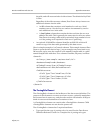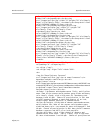
Polycom Digital Signage Administrator Guide Data Source Definition File Overview
176 Polycom, Inc.
• URL can be used to specify a new source that is only used for the parsing
rules contained in the <DataItem> element. The URL is resolved and its
contents are placed into the "Source" container before any of the
DataItem's parsing rules are applied.
• NumRecords specifies how many times to apply the DataItem's parsing
rules. Any <ParsingRule> elements contained in a <DataItem> are applied
in their order of appearance up to NumRecords times, or until an
index-aware parsing rule returns an empty value.
Each time a DataItem's parsing rules are applied, the rules' Results are written
into a new set of empty containers. A new row is added to the data table being
created, and any parsing rule Results that identify a data table field are written
to the new row.
Setting NumRecords to 0 (which is the default value) is the same as setting it
to 999.
Here is a simple example of a <DataItem> element that contains a single
parsing rule. The following defines a table with a City column and adds 5 rows
to that table, each containing the value "New York, NY".
<DataSource>
<General>
<RefreshInterval>…</RefreshInterval>
<AllowDuplicates>…</AllowDuplicates>
<Url>…</Url>
<Database>…</Database>
<TableStructure Name="SampleTable">
<Field Type="Text">City</Field>
</TableStructure>
</General>
<DataItem NumRecords="5">
<ParsingRule Type="SetValue" Result="City">
<Value>New York, NY</Value>
</ParsingRule>
</DataItem>
</DataSource>
Here how to use a <DataItem> element to parse the string "(x=1)(y=2)(z=3)".
Assume we want to extract each equation's variable (x or y or z) and value (1
or 2 or 3).
<DataItem>
<ParsingRule Type="GetTag" Source="Source" Result="Equation">
<StartTag>(</StartTag>
<EndTag>)</EndTag>
</ParsingRule>


















